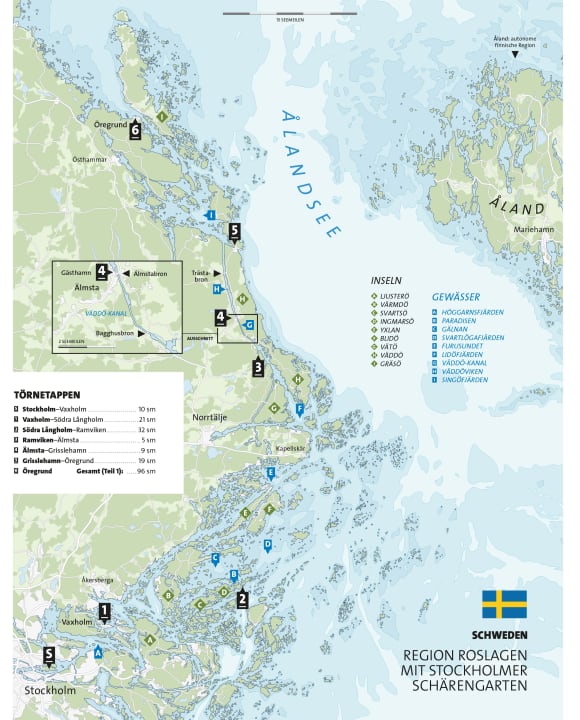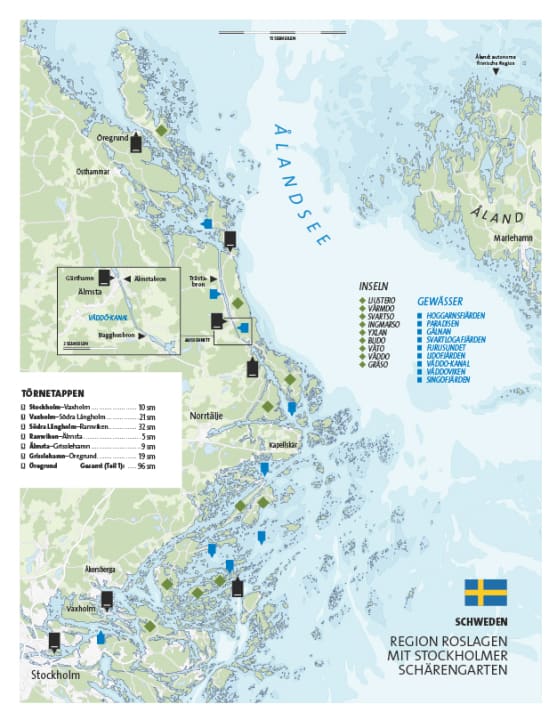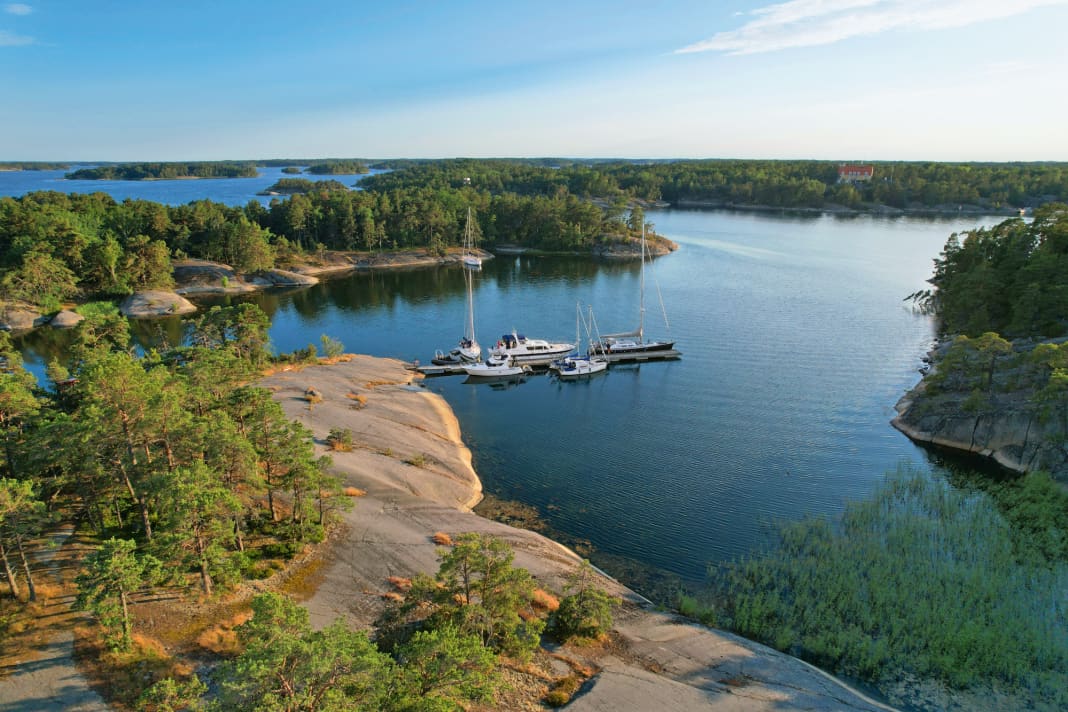Stockholm is full of people, a surging crowd in the heart of the city. Sunglasses flash. You can hear the exuberance in the cafés along the stately façades of Strandvägen. It's the first weekend in July, summer has arrived in Sweden! The waters of Nybroviken are teeming with water taxis, pleasure boats and excursion steamers. The sailing yachts of the City Regatta, a major international event that starts tomorrow, are also crowded along the harbour walls. This is another reason why we want to leave today - even if it is difficult in this atmosphere.
We, that's Maggie, Lothar, Marc and I, the crew of the "Rolling Swiss 2" for the next two weeks. Together we want to sail the Trader 42, which follows the Cruising Club of Switzerland explore some of the most beautiful corners of the Baltic Sea. We start with the historic coastal region of Roslagen: from Vaxholm, our destination for today, it stretches across the northern Stockholm archipelago and the adjoining waterways, which are reminiscent of tranquil inland journeys, up north to Öregrund, our last stop in Sweden. From there, the second part of the journey will take us to the "happy islands": Åland.
Start in Stockholm
We leave the Biskopsudden marina on the island of Djurgården under a sky that makes even the blue of the Swedish flag fade. The royal capital remains astern. A call to the harbour master at Vaxholm suggests that a berth might be available. Sounds good! So we head north-west as quickly as possible, together with large and small ferries and some swell. The first skerries come into view, with holiday homes and waving pennants. They are neat villas with a view over the water, a few small castles, dreams made of wood. If you have your jetty here, you can't be too badly off!
After a good hour, we cross the Långholmsfjärden and approach Vaxholm. To the left is the imposing fortress with the passage to the north, to the left the village, a pier with skerry steamers and the marina. From the bar on the pier head, we are greeted cheerfully with raised glasses of beer as we enter the harbour. The harbour master, a marinero in a Viking look, guides us into the last gap. A little tight, but it fits. We hand over the mooring line and tie up.

Vaxholm
The harbour is pure Sweden, with red stalls (boutiques that have already closed), the harbour master's office, a grill and another full bar. Two young women tap craft beer at the bar. In the harbour: lots of foreign flags, Belgium, Finland, of course black, red and gold. Even two New Zealanders are enjoying the northern hemisphere summer on the deck of their ketch "Kiwi" until the long shadows of late dusk creep into the harbour. The four of us sit around the large map of the northern archipelago. Our destination for tomorrow is "right next to paradise". At least that's what the cruising guide promises. We take him at his word!
The fortress museum
Sunday, 3 July: We are supposed to have left the harbour by noon at the latest, but because we want to visit the fortress museum, which doesn't open until eleven, we are allowed to stay longer. The reservation sign on the jetty is quickly changed, the Finn with the Targa next to us has already left at an early hour and his place is free. We take the cable ferry across to the fortress island right on time; the return journey costs nine euros. The complex is imposing and well preserved - but this is also due to the fact that at the time of the last reconstruction, in the first half of the nineteenth century, the long period of peace in Sweden had already begun. All the better, because militarily the block would have been outdated long ago. It was therefore primarily used as a training centre.
Inside, there are cannons and guns of various eras and calibres everywhere, including in the large, wedge-shaped courtyard, a prime example of the fortified architecture of bygone times. From the wall you have a good view of the fjord, on which the sun sparkles in the backlight. This is where the traffic crosses, even though very large ships such as the Åland ferries use the wider main fairway further south. The museum advertises itself as the largest in the archipelago. Just as Vaxholm is probably its largest town. However, the three floors are dedicated to military history, from the Great Northern War to the Cold War: "Sweden's peace and freedom are protected by its weapons". From infantrymen with tricorn hats and muskets to frogmen with assault rifles.
The old town
On the way back, the old town that the harbour master praised yesterday gets a chance. The little Torget on the hill off Hamngatan is pretty. It's no coincidence that the tourist information centre, a well-stocked souvenir shop and a number of spruced-up cafés and shops can be found here. White wood and blooming roses, that's how it should be. The four of us stroll past the church back to the harbour. The island actually has a bridge connection to the mainland. No wonder it's so crowded everywhere. On the one hand, Vaxholm itself attracts day trippers, and on the other, it's the many small scheduled boats that leave from here for the archipelago. The digital display board at the harbour lists a good dozen connections. A crowd of Americans is also noisily at the start, apparently cruise passengers on a Eurotour in Sweden. But Vaxholm was also the perfect introduction to the cruise and the area for us.
To the northern archipelago
We cast off and head between the islands, first to the north, then to the east, out into the archipelago. The City Regatta crosses our route twice, travelling with all classes under full sail, an endless procession of sails. We round the southern tip of the large island of Ljusterö and then pass Svartsö and Ingmarsö. It's getting lonelier now, the holiday homes fewer and farther between.
But just when we think we might be alone in the evening, we reach Paradisen. Slowly, between the rocks, we follow the fairway across the natural harbour with the heavenly name - and there really is a lot going on here. At least two dozen boats are already moored at the buoys or at the stern anchor on jetties and rocks, almost exclusively Swedes. Some are even anchored. The smell of a barbecue wafts across the bay.
On Söder-Långholm
It's just as well that we want to go a little further to the neighbouring island of Söder-Långholm. The spot we have chosen "right next to paradise" is much smaller, but even more beautiful (or so we think). And although we have already laid out the stern anchor, triple line and bow ladder, there is still just one free place alongside the small floating jetty, between two sailors from England and Finland.
Only when we have already moored do I read on the welcome sign on the shore what the price is for so much beauty. If you moor properly, i.e. with the bow, you pay 150 crowns. On the long side it's 1000 crowns. Of course, as many crews as possible should be able to stay here. But just under 90 euros is a considerable sum, even in Sweden. As everyone else is also moored alongside, we hang fenders on the free side in case anyone wants to get into the packet and wait to see what happens.
The island is a dream. Smoothly polished rocks at the water's edge, sparse pine forest further up. Reeds in sheltered places, making it difficult to say for sure where the land ends. As we sit on the aft deck, the blue sky that had been hiding all day comes closer again. Finally, golden evening light floods the bay. With a beer in my rucksack, I climb up, sit on the warm stone and launch the drone for one of the most beautiful flights ever. You'd have to be a seagull! Maggie and Lothar also go exploring and take the opportunity to go for a swim.
In the meantime, the harbour master arrives with the rigid-hulled inflatable boat to collect the money: As the season hasn't started yet, we can choose how much we want to pay. Marc suggests 500 crowns, which is still a considerable sum. But we've made it easy for ourselves... Our feast on board to celebrate this day properly must be mentioned: Caprese as a starter, salmon as a main course and ice cream with fruit for dessert. Later, silence in the bay. The wind falls asleep. The new moon is in the cloudless sky. The Nordic summer night is far too bright for stars.
Continue through the archipelago
Monday, 4 July:The bathtub weather is over for now, it's getting fresher. The wind is still coming from the south, but will shift to the west in the next few days. It has already picked up and in the shadow of the fast-moving cumulus clouds it is cooling down considerably, 19 degrees instead of 23. The fairway is now winding its way through more open waters and traffic is also sparse.
We sail through the archipelago that separates Gälnan and Svartlögafjärden and then head into the six-mile-long sound between the islands of Yxlan and Blidö. Pine-lined shores, only a few jetties and huts. In Furusundsfjärden we return to the main fairway of the northern approach to Stockholm before following the coast again at Kapellskär. We leave Norrtälje, an important industrial town for Sweden, on our left.
Our overview map of the archipelago ends here. We hardly know anything about what follows - and that's exactly why we chose this route. Yesterday's late-night cruise planning determined that we wanted to spend the night in Älmsta, where the short Väddö Canal ends and the long sound that separates the island of the same name from the mainland begins. The fjord is now getting narrower and narrower, with Väddö already on the right.
As we are well in time, we spontaneously drop anchor in Ramviken. The bay is shaped like a U and is so beautiful that you could easily stay here. However, it's still far too early for that, just 3 pm. So I go for a spin, Lothar puts his rod in the water, again with no luck (his trap this morning on Söder-Långholm produced two tiny fish), but we treat ourselves to a round of Falcon alkoholfri.
On the Väddö Canal
Anchor up and into the Väddö Canal, which initially runs through meadows lined with reeds to the first bridge at Bagghus (swing bridge, 6.20 m clear height, opening on the half hour). With antennas in place, we can also pass it closed. Suddenly we are in the Uckermark, at least it feels like it, with forest on both sides of the straight waterway. A green tunnel through which the sun shines. Calm water that you would never think was part of the sea.
Is there anything else like it in Sweden, or anywhere else on the Baltic Sea? Probably not. A really successful surprise, the contrast to the first half of today's stage really couldn't be greater. A small, equally picturesque inland lake follows, then we reach the waiting jetty in front of the bascule bridge at Älmsta. It is closed and too low for us, so we have to wait (bascule bridge, 4.50 m clearance, opens on the hour).
Älmsta
A fine rain sets in. As our harbour is only a few hundred metres away on the other side, I put on my poncho and head off to register. The old couple at the harbour office don't speak much English, but for 400 crowns we get a nice spot alongside. The bell on the bridge rattles and the barriers close.
Our trader passes the now open Älmstabron under the gaze of day-trippers. Less than five minutes later, she is comfortably moored at the Gästhamn floating dock. The canal ends here again and merges into the ten nautical mile long Väddöviken, a bay that from here looks like an elongated lake between narrow banks. This is also reminiscent of the Mecklenburg Lake District.
There are about ten boats here with us, locals and some Finns. They also tell us that the sauna is heated up in the evening. But the Finn who sweats with us later is not convinced: the temperature and benches are too low. He laughs: "In Sweden, everything is actually a bit better than in Finland. Except for the sauna". He wants to continue on to Stockholm with his family, they are on a five-week cruise. The children were lured on board with a visit to the Gröna Lund amusement park. After that (at least enough for us), it's time to cool off in the Baltic Sea. Gently though, via the ladder on the jetty.
The Väddöviken
Tuesday, 5 July: Our "inland cruise" continues. Holiday homes and campsites line the green, flat banks of the Väddöviken. People swim from jetties and small beaches among the reeds. There are also yachts passing through, like us, and small holiday boats. A maximum of five knots is permitted on the narrow stretches, which give the waterway the appearance of a chain of lakes. We take the opportunity to take our first photos of the "Rolling Swiss" from a jetty. Although it is mostly cloudy, we catch a hole in the clouds.
Back on board, I leaf through a promotional magazine from the supermarket in Älmsta, where I got a few bottles of Sommar Lager from the local bryggeri the morning before we set sail. The tourist brochure is named after the region: Roslagen. I've never heard of it before. I'm all the more surprised when I see the map. Its borders stretch from Vaxholm in the south to Öregrund in the north - and thus cover the exact area of our first part of the journey. In earlier times, Roslagen's villages and farms provided the rowers for the royal fleet in the archipelago, hence the name.
After just under an hour, we pass the Trästabron, a road bridge with a clearance of 15 metres, which is no problem for us. As our anchor stop yesterday made the journey more relaxed, we want to take a break again today, in Grisslehamn. Where the Väddöviken flows into the Singöfjärden, we turn to the east, where the small village lies in a bay at the end of the Örnöfjärden.
Grisslehamn
Mooring is more strenuous than expected; the floating jetty has fairly short jibs and we are buffeted back and forth in the fresh wind until - after confirmation by phone - we head for a box. Fortunately, everything works out and three springs keep our bow safely away from the edge of the jetty. However, the bow ladder is used for the first time. We want to stay for just under two hours.
Grisslehamn lies between two coasts at the narrowest point of Väddö. From the open sea side, the Eckerö Linjen ferries cross over from Sweden to Åland, which belongs to Finland. Through traffic is therefore guaranteed. A large campsite, which also includes Gästhamn, caters for other holidaymakers. They enjoy the occasional rays of sunshine while playing punch and mini golf. Meanwhile, in the bay, the optis and mini dinghies of the sailing school do their circles. Art and coffee are on offer everywhere.
A motor yacht moored alongside the boat club is loaded with duty-free beer. There's no other way to put it. It's obviously worth it: one trip there and back on the ferry, then piling your own boat up to the scuppers with the pallets you bought cheaply on board and speeding back to Stockholm at full throttle. Modern, completely legal smuggling.
We head further north-west. The sun has gone, the wind is suddenly icy. More sea space between the skerries, now densely forested and reminiscent of Canada. Small lighthouses and lighted buoys mark the fairway, which we have to ourselves. With the island of Gräsö to starboard, we finally reach our destination for the day: Öregrund.
Öregrund
We let the ferry pass and enter the harbour. A lightship on the rock and an old two-master greet us on the left. As expected, pretty wooden houses surround the harbour. The harbour master waves us over, but not to the front jetty with the sailors. Instead, we get two murings at the central pier and are soon lying with our bows to the land.
Even the first short excursion makes it clear that we have hit the bull's eye here. A really pretty place that also has a lot more to offer, as the information flyer reveals: for example, that Öregrund is the only place on the Swedish east coast where you can watch the sun set over the sea from the mainland. The special location on the northern tip of a peninsula makes this possible.
While we are still enjoying our aperitif on board, the cafés and restaurants on the waterfront are filling up: the Hamnkrogen, the Boja-Bäs, the Slupen. I walk round the bay to the former lightship with my camera. In active times, the "Västra Banken" was moored around forty nautical miles north-west of here in the Bothnian Sea. She now spends her retirement high and dry on the coastal rocks - at least her deck with superstructure and lantern, which have been preserved as a monument.
Across the road at Gula Huset, the live music is already starting and it's going to be a big party: "Säg mig var du står!". Things are quieter at Strandnära: cool blues, a very chilled-out place. Beach bar, Scandi style. We would have stayed longer if it wasn't for the sunset. Kitsch, of course! But if such an image is ever really justified, it's here and now, isn't it? The golden spectacle is not the only celestial event: much later, when Carola's evergreens in the Gula Huset have fallen silent again, glowing night clouds still cover the sky. It's time to say goodbye to Sweden, Åland awaits!
Service

Cruising stages
S: Stockholm-Vaxholm: 10 nm
- Vaxholm-Södra Långholm: 21 nm
- Södra Långholm-Ramviken: 32 nm
- Ramviken-Älmsta: 5 nm
- Älmsta-Grisslehamn: 9 nm
- Grisslehamn-Öregrund: 19 nm
6: Öregrund (total part 1): 96 nm
OUR BOAT:Trader 42 (GRP semi-planing) - Length: 13.30 m - Width: 4.30 m - Height: 3.80 m - Draft: 1.20 m - Berths: 6 (in 3 double cabins) - WC/shower: 2/2 - CE category: A - Motorisation: 2 x380 hp (Cummins diesel) - Special equipment: VHF radio system, autopilot, plotter with radar and AIS overlay (active and passive), generator, EPIRB, bow thruster, dinghy with 15 hp outboard in davits
THE CLUB:On this trip, we travelled with the Cruising Club of Switzerland (CCS). With around 6,500 members, the Bern-based Central Club is one of the largest water sports clubs in Switzerland and is a leader in the country's recreational boating sector when it comes to offshore training. The motorboat division forms its own subdivision within the club with its own yacht, which is used for training and cruises in northern and western Europe. In the 2023 cruising season, the cruise programme will lead from Kiel through the western Baltic Sea, Kattegat and Skagerrak via Copenhagen, Gothenburg and Oslo back to Kiel.
Nautical information
THE STOCKHOLM ARCHIPELAGOwith around 25,000 inhabited and uninhabited islands, skerries and rocks, is the second largest archipelago in the Baltic Sea after the Finnish Archipelago Sea. It stretches for around 80 nautical miles from Landsort in the south to Arholma in the north. Many of the larger islands, such as Ljusterö and Vindö, are popular holiday and excursion destinations. There are numerous destinations for sports skippers, from genuine guest harbours to natural moorings without infrastructure. In the northern half of the archipelago alone, the nautical literature (see page 44) lists more than one hundred suitable places. The fairways marked on the nautical charts are buoyed; outside these, you must navigate with the utmost care, as there are many shallow places even in larger areas of water.
THE VÄDDÖ CHANNELcrosses the former mainland connection of the island of the same name. It is around three nautical miles long and two metres deep. There are two movable bridges along its course, at Bagghus in the south and Älmsta in the north.







